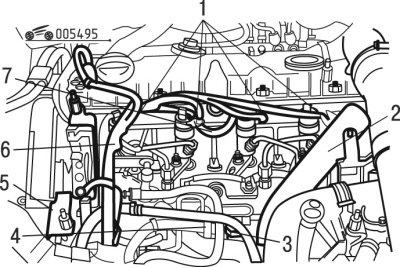- label 1 (in the form of a spot of blue paint -class 1 nozzle);
- label 2 (in the form of a spot of green paint -class 2 nozzle).

Pic. 4.94. Injector markings: A - supplier; B - identification number of the Peugeot company; C -class identification
In the marking shown in Fig. 4.94, are specified:
- provider (A);
- Peugeot identification number (B);
- class identification (C).
Attention! When replacing injectors, 4 injectors of the same class must be installed on the engine.
When removing and installing fuel injectors at Peugeot service centers, use the following special tool:
- tubing wrench - 1603-F (4220-TD);
- tubing wrench - 1603-G (4220-TC);
- plug set - 0188-T;
- compression sleeve 1603-A/E/B/D [4220-T (B-G-J)].
Remove the fuel injectors in the following order:
- remove the protective casing of the engine;
- disconnect the wire from the negative terminal of the battery;

Pic. 4.95. Removing parts of the fuel system: 1 - contact connectors; 2 - tube; 3, 4 - sensors; 5 - support; 6 - wiring harness; 7 - branch pipe
- disconnect sensors 3 and 4 (pic. 4.95);
- disconnect the connectors 1 of the injectors;
- move aside the tube 2 of the oil aerosol catcher;
- take aside the wiring harness 6;
Attention! Each time the high pressure hoses are removed, they must be replaced with new ones.
- remove branch pipe 7 for fuel return;
- close the holes with the tool;
- remove support 5;
Attention! Clean the fuel line fittings before unscrewing them.

Pic. 4.96. Applying a locking compound in zone A
- apply locking compound in zone A (pic. 4.96);
- unscrew the connecting elements;

Pic. 4.97. Applying a locking compound in zone B
- apply locking compound in zone B (pic. 4.97);
- unscrew the connecting elements on the fuel distributor;

Pic. 4.98. Fuel Injector Details: 1, 4 - plugs; 2, 11 - nuts; 3 - nozzle; 5 - sealing ring; 6 - leather gasket; 7 - hairpin; 8 - thrust washer; 9 - bracket; 10 - washer
- remove the four high pressure pipes;
Attention! Don't touch the nut 2 (pic. 4.98).
- unscrew the nuts of 11 nozzles;
- remove washers 10;
- remove brackets 9 fastening nozzles;
- remove nozzles 3;
- remove sealing rings 5;
- remove leather pads 6;
- remove thrust washers 8;
Note. If it is not possible to remove the injector, remove the pin 7 with the lock nut, then use a flat wrench to turn the injector in the area of flat A.
- plug holes 1 and 4 of the injectors.
Install the fuel injectors in the following order:
Attention! WarningsReplace the removed high-pressure fuel lines. When unscrewing nuts 11, studs 7 may unscrew together with nuts, in this case, when reinstalling the studs, be sure to orient the studs in the correct direction (do not install upside down).
- screw the studs into the cylinder head with the nut and locknut, tightening to 7.5 Nm;
Attention! When reinstalling, observe the correct bending direction of the bracket 9. Observe the correct mounting direction of the washers 10.
- remove the plugs from the nozzle holes;
- install thrust washers 8;
- install new leather gaskets 6;
- install new sealing rings 5;
- install nozzles 3, fixing them with brackets 9;
- install washers 10;
- install new nuts 11;
- fix the high pressure fuel lines on the injectors and fuel distributor;
- tighten nuts 11 to 30 Nm;
- apply locking compound in zone A (see fig. 4.96);
- tighten the fastening of the high-pressure fuel lines using tools to a torque of 20 Nm;
- apply locking compound in zone B (see fig. 4.97);
- install caliper 5 (see fig. 4.95);
- install branch pipe 7;
- reinstall wiring harness 6;
- reinstall pipe 2;
- connect the connectors 1 to the injectors;
- connect the wire to the negative battery terminal;
- check the tightness of the connections by setting the engine speed to 1000 min-1 and pressing the accelerator pedal, setting the crankshaft speed to 3500 min-1.
Complete installation in the reverse order of removal.
